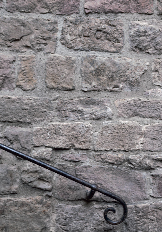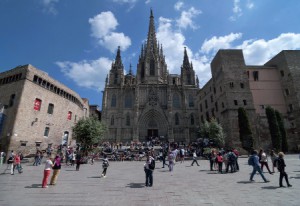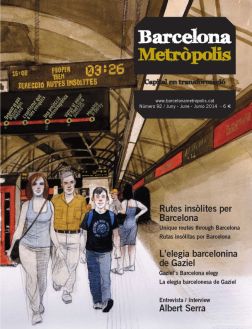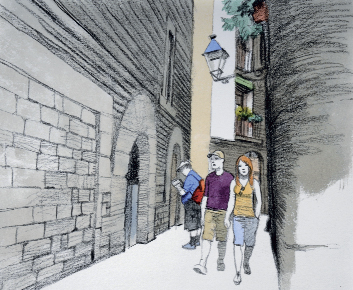In the streets and squares of the three Barcelonas evoked by Robert Hughes, metropolitan, mediaeval and Roman, over two thousand years of history are summarised with a continuity comparable to that of European state capitals like London, Paris and Rome.
Robert Hughes, author of the most internationally significant work on Barcelona ever, claimed the Catalan capital was, in fact, three cities in one: the metropolitan city stretched between the rivers with the Eixample and the surrounding, perfectly defined, neighbourhoods, within which there is a clearly defined older town, the mediaeval Ciutat Vella, which itself contains yet another, more archaic settlement, the ancient Roman city of Barcino. With his words, the prestigious Australian art critic was proposing a route through Barcelona and its more than two thousand years of history. Let’s look, for example, at three areas representing key periods of history in this bimillennial city: the Barcelona of the Roman period and Early Middle Ages, the Late Mediaeval Gothic city, and the metropolis of the early 20th century.
In recent years, archaeology has recovered one of the most surprising finds in the history of Barcelona: the Christian Visigothic cathedral hidden beneath the Basilica of Sants Just i Pastor (Plaça de Sant Just, 1). It is the baptistery of a cathedral mentioned in ancient documents but which until now had never been proved archaeologically: the most important temple for the local Catholic population in the 6th century, when the city was governed by elite Visigoths who practised Arianism and worshipped on the site of the current cathedral.
This discovery is part of the Pla Barcino, an ambitious plan to reclaim the cultural heritage of Roman and Visigothic Barcelona and make it available to the public through all kinds of public events, including the Urban Archaeology Service website, http://cartaarqueologica.bcn.cat, which lists more than three thousand places of interest spanning the entire history of the city.

© Dani Codina
The remains of the gravestones reused for the walls of the Palau del Lloctinent, visible in the courtyard of the Museu Marès.
Like a palimpsest
Barcelona’s history can be read like a palimpsest. In ancient times, scribes were often forced to reuse the same parchments, removing the existing texts and adding new ones. By analysing them, literary critics have recovered the value of these texts, which, under the guise of a single document, hide several stories, some more obvious than others. In the same way, the history of the city is written on its stones, and in its documents, not only in what we can see at first glance but also everything that has been deliberately destroyed and goes unnoticed. A typical example is the archaeological subsoil of the old Born market (Plaça Comercial 12), together with the remains of the Ribera neighbourhood that was destroyed by order of the Bourbon authorities, post-1714. Centuries before this, the 1391 annihilation of the local Jewish community and the physical destruction of their quarter, El Call, had been its equally bloody and traumatic forerunner.
The names in the area round Placeta de Manuel Ribé remind passers-by of the Jewish presence in mediaeval Barchinona. From Plaça de Sant Jaume it is easy to enter El Call, either by following the street of the same name and then continuing down Sant Domènec del Call, or along Carrer Sant Honorat and then down Carrer Fruita. Both lead the pedestrian to what is considered to be the site of the main synagogue (Carrer de Marlet, 5). A few steps away a Hebrew marker stone – in fact it is just a copy; the original is preserved in the Museu d’Història de Barcelona – recalls the 13thcentury founding of a hospital for the needy (C. Marlet, 1).
A visit to the El Call Interpretation Centre (Placeta de Manuel Ribé, 3) is essential in order to discover the impression Jewish Barcelona left on other places in the city, like the remains of the necropolis on Montjuïc, recently declared a Cultural Asset of National Interest, the tombstones that have been reused as building materials in the Palau del Lloctinent (Carrer dels Comtes, 2), and the subsoil of the Saló del Tinell (Plaça del Rei, 9). Despite the destructive efforts of the Mediaeval Christian city to wipe out the Jewish one, the remains of El Call crop out, unstoppably, in modern Barcelona, just like on a palimpsest.
The Middle Ages revisited in the 20th century
The cathedral quarter, more popularly known as the Barri Gòtic [Gothic Quarter], is a slice of the city where Barcelona reveals itself to be an urban patchwork. Today, the truly mediaeval constructions, like the Romanesque Santa Llúcia Chapel (Carrer de Santa Llúcia, 3) and the Gothic Santa Àgata Chapel (Plaça del Rei, 9), jostle with buildings that were substantially remodelled in the mid-20th century, such as the home of the Centre Excursionista de Catalunya and the remains of a Roman temple (Carrer del Paradís, 10), the Palau Reial Major and the Saló del Tinell in Plaça del Rei, and, above all, the Casa dels Canonges (Carrer de la Pietat, 2). Connected to the neighbouring Palau de la Generalitat via a 1928 neo-Gothic bridge across Carrer del Bisbe, the reinvention of this building in the 1920s is considered to be the founding action for the modern Barri Gòtic.
Even more surprising is the story of the travelling buildings, like Casa Padellàs (Carrer del Veguer, 2), transported stone by stone from its original location in Carrer dels Mercaders to where it now rests at the monumental site in Plaça del Rei, an act that made it possible to uncover the archaelogically important Roman subsoil.
In the case of the Cathedral, the contrast in historical periods and artistic styles is subtle, from the late 19th century neo-Gothic facade to the rest of the essentially mediaeval building. In front of it, two more buildings, Pia Almoïna, home of the Museu Diocesà (Avinguda de la Catedral, 4), and Casa de l’Ardiaca, home of the City History Archives (Carrer de Santa Llúcia, 1), are both good examples of how mediaeval buildings constructed on the ancient Roman wall have gradually been transformed, becoming modern sites whose architectural evolution relates two thousand years of urban history.

© Dani Codina
The cathedral, with a Neo-Gothic nineteenth century façade, between Pia Almoina and the Casa de l’Ardiaca, historic buildings with contemporary interventions: examples of the mix of styles and eras that speak to us of two thousand year history.
The Barri Gòtic is anything but an invented neighbourhood, as is often claimed. Its transformation is the result of a perfectly designed plan responding to the opening up of Via Laietana in 1908 and a 1922 conference on making the Cathedral Quarter into a monument. The plan was carried out by the architect Adolf Florensa and the archaeologist and archivist Agustí Duran i Sanpere. One aspect of the Barri Gòtic that still draws the attention of locals and visitors alike is the solidity and the absolute pre-eminence of the stone facades. In 1511, the Florentine ambassador Francesco Guicciardini wrote in his travel journal, his Diario del viaggio in Spagna: unlike other peninsular towns, Barcelona stands out for having a city which is principally built of stone.
In the streets and squares of the three Barcelonas evoked by Robert Hughes, over two thousand years of history are summarised with a continuity only comparable to that of European state capitals like London, Paris and Rome.





